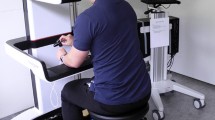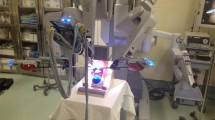Abstract
Introduction and hypothesis
The Miya Model ™ (Miyazaki Enterprises, Winston-Salem, NC, USA) was designed as a realistic vaginal surgery simulation model. Our aim was to describe this model and present pilot data on validity and reliability of the model as an assessment tool of vaginal hysterectomy skills.
Methods
We video recorded ten obstetrics and gynecology residents (novice group) and ten practicing gynecologists (expert group) performing vaginal hysterectomy using the Miya model. Blood loss and time taken to complete the procedure were documented. Participants evaluated the model using a postsimulation survey. In addition, two experienced gynecologic surgeons independently evaluated video recordings of each participant’s performance using two previously validated global rating scales: Reznick’s Objective Structured Assessment of Technical Skill (OSATS) and Vaginal Surgical Skills Index (VSSI).
Results
Most participants (80% of novice and 100% of expert group) rated the model as effective or highly effective for vaginal hysterectomy training and assessment. Median time to procedure completion was significantly higher in the novice group, whereas median estimated blood loss was no different between groups. No significant differences were observed in the composite median OSATS or VSSI scores between groups. The interrater reliability indices for subscales and composite scores of the OSATS and VSSI were high and ranged from 0.79 to 0.90 and 0.77 to 0.93, respectively.
Conclusions
With further study, the Miya Model may be a useful tool for teaching and assessing vaginal surgical skills.

Similar content being viewed by others
References
Aarts JWM, Nieboer TE, Johnson N, et al. Surgical approach to hysterectomy for benign gynaecological disease. Cochrane Database Syst Rev. 2015;CD003677. https://doi.org/10.1002/14651858.CD003677.pub5.
Carbonnel M, Abbou H, N’Guyen HT, et al. Robotically assisted hysterectomy versus vaginal hysterectomy for benign disease: a prospective study. Minim Invasive Surg. 2013;2013 https://doi.org/10.1155/2013/429105.
Nanavati AM, Gokral SB. A prospective randomized comparative study of vaginal, abdominal, and laparoscopic hysterectomies. J Obstet Gynaecol India. 2016;66:389–94. https://doi.org/10.1007/s13224-015-0756-z.
Wright JD, Herzog TJ, Tsui J, et al. Nationwide trends in the performance of inpatient hysterectomy in the United States. Obstet Gynecol. 2013;122:233–41. https://doi.org/10.1097/AOG.0b013e318299a6cf.
Burkett D, Horwitz J, Kennedy V, et al. Assessing current trends in resident hysterectomy training. Female Pelvic Med Reconstr Surg. 2011;17:210–4. https://doi.org/10.1097/SPV.0b013e3182309a22.
Case logs statistical reports. https://acgme.org/Data-Collection-Systems/Case-Logs-Statistical-Reports. Accessed 16 Feb 2018.
Chao TT, Fleming M, Hartmann D, et al. The obstetrics and gynecology milestone project. J Grad Med Educ. 2014;6:129–43. https://doi.org/10.4300/JGME-06-01s1-07.
Nasca TJ, Philibert I, Brigham T, Flynn TC. The next GME accreditation system — rationale and benefits. N Engl J Med. 2012;366:1051–6. https://doi.org/10.1056/NEJMsr1200117.
ABOG announces new eligibility requirement for board certification. In: Fundamentals of Laparoscopic Surgery. 2018. https://www.flsprogram.org/news/abog-announces-new-eligibility-requirement-board-certification/. Accessed 5 Feb 2018.
The Council on Resident Education in Obstetrics and Gynecology (CREOG), the American College of Obstetricians and Gynecologists (ACOG), Surgical Curriculum in Obstetrics and Gynecology, Vaginal hysterectomy module. https://cfweb.acog.org/scog/scog008. Accessed 12 Feb 2018
Chen CCG, Korn A, Klingele C, et al. Objective assessment of vaginal surgical skills. Am J Obstet Gynecol. 2010;203:79.e1–8. https://doi.org/10.1016/j.ajog.2010.01.072.
Reznick R, Regehr G, MacRae H, et al. Testing technical skill via an innovative bench station examination. Am J Surg. 1997;173:226–30.
Aggarwal R, Darzi A. Technical-skills training in the 21st century. N Engl J Med. 2006;355:2695–6. https://doi.org/10.1056/NEJMe068179.
Nwamaka M-A, Onwugbenu M. Vaginal hysterectomy simulation: adjunct training. Obstet Gynecol. 2015;126:53S–4S. https://doi.org/10.1097/01.AOG.0000471097.04946.d9.
Barrier BF, Thompson AB, McCullough MW, Occhino JA. A novel and inexpensive vaginal hysterectomy simulator. Simul Healthc. 2012;7:374–9. https://doi.org/10.1097/SIH.0b013e318266d0c6.
Greer JA, Segal S, Salva CR, Arya LA. Development and validation of simulation training for vaginal hysterectomy. J Minim Invasive Gynecol. 2014;21:74–82. https://doi.org/10.1016/j.jmig.2013.06.006.
Acknowledgements
This study is funded by The Eunice Kennedy Shriver National Institute of Child Health and Human Development, National Institutes of Health, grant number: 1R43HD084151-01. We would like to thank all of our 3rd-year medical students at the Wake Forest School of Medicine who volunteered their time as surgical assistants: Lucy Lan, Shannon Mentock, Mathew Fore, Breona Barr, Porvi Chbabra, Jennifer Udom, David Crouse, Sophia Wang, Barclay Mcghee, Vanessa Ng, James Kaan, Joshua Pan, Jia Hao Liang, and Jacob Blackwell. We also greatly appreciate our videographers: head videographer John Beasley; volunteers: Mitchell Avent, Devin Williams, Bree Hollowell, Ryan Miyazaki, and Katherine Bowman.
Author information
Authors and Affiliations
Corresponding author
Ethics declarations
Conflicts of interest
Douglas Miyazaki, founder and chief executive officer of Miyazaki Enterprises, speaker for Astora and Boston Scientific.
Catherine Matthews, grant funding from Boston Scientific; Pelvalon. Consultant for Pelvalon.
Mujan Varasteh Kia, Amr Sherif El Haraki, and Chi Chiung Grace Chen, no disclosures.
Noah Miyazaki, vice president of Business Development, Miyazaki Enterprises.
Rights and permissions
About this article
Cite this article
Miyazaki, D., Matthews, C.A., Kia, M.V. et al. Validation of an educational simulation model for vaginal hysterectomy training: a pilot study. Int Urogynecol J 30, 1329–1336 (2019). https://doi.org/10.1007/s00192-018-3761-9
Received:
Accepted:
Published:
Issue Date:
DOI: https://doi.org/10.1007/s00192-018-3761-9




